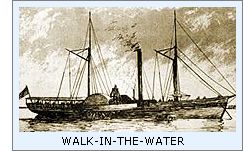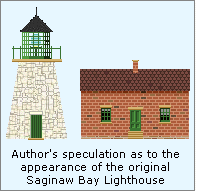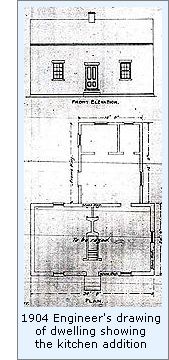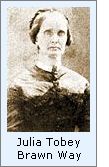|
Historical Information

As readily available timber around the Detroit area disappeared,
lumbering interests set their sites on the seemingly endless forests
along the shores of Lake Huron to the north. While Gardner D. Williams
is recorded as the first lumber man to set up lumbering operations on
the Saginaw River in 1826, it was his nephew Harvey who arrived to put
the river "on the map" in 1834 when he made his way up the
river in a schooner with a one of a kind cargo strapped to the vessel's
deck. With backing from his cousins Gardner D and Ephraim S Williams,
Harvey had obtained an old steam engine which had reputedly been
installed in the WALK-IN-THE-WATER, the first steamer to ply the waters
between Black Rock and Mackinac. An excellent blacksmith and mechanic,
Harvey had personally forged the ironwork needed to adapt the engine to
his intended purpose, and by early 1835 the venerable engine was
powering the River's first steam-powered sawmill. However "Uncle
Harvey," was not to reap the area's bounty alone, as other mills
would quickly appear along the river's entire navigable length.
 With a significant increase in the
number of vessels seeking entry into the river expected, maritime
interests began complaining of the difficulty encountered in finding the
narrow entry across the bar at the river's mouth. Taking up their call
on January 26 1835, Michigan Senator Lucius Lyon presented a petition of
112 signatures to Congress, "praying that an appropriation may be
made for the purpose of erecting a light-house at the confluence of
Saginaw river with Lake Huron, and improving the navigation of said
river and its tributary streams." However, unfamiliar with the
needs of the developing frontier area, Congress referred the matter to
the Commerce Committee for evaluation. While the Commerce Committee
concurred with the need, and a number of subsequent memorials were
presented in both houses, Congress did not respond to the request until
March 3, 1837, when the sum of five thousand dollars was finally
appropriated for the construction of a lighthouse at the river mouth.
However, with the country in the grips of an economic recession,
establishment of the station was postponed indefinitely. With a significant increase in the
number of vessels seeking entry into the river expected, maritime
interests began complaining of the difficulty encountered in finding the
narrow entry across the bar at the river's mouth. Taking up their call
on January 26 1835, Michigan Senator Lucius Lyon presented a petition of
112 signatures to Congress, "praying that an appropriation may be
made for the purpose of erecting a light-house at the confluence of
Saginaw river with Lake Huron, and improving the navigation of said
river and its tributary streams." However, unfamiliar with the
needs of the developing frontier area, Congress referred the matter to
the Commerce Committee for evaluation. While the Commerce Committee
concurred with the need, and a number of subsequent memorials were
presented in both houses, Congress did not respond to the request until
March 3, 1837, when the sum of five thousand dollars was finally
appropriated for the construction of a lighthouse at the river mouth.
However, with the country in the grips of an economic recession,
establishment of the station was postponed indefinitely.
Arriving in the river in the summer of
1838 to conduct an inspection of all existing and planned lighthouses on
the Great Lakes, Navy Lieutenant James T Homans concurred with the need
for a lighthouse at the river mouth, reporting that "the commerce
of this place is considerable, and increasing; the lumber trade alone
will soon be of important value, and well worthy of this guide to its
location." To provide a location for the Light, on February 21 of
the following year, President Martin Van Buren ordered the Bureau of
Indian Affairs to enter into a treaty with the Chippewa for the transfer
of forty acres on the western side of the river mouth for lighthouse
purposes.
 A contract for the station's
construction was awarded to a Captain Stephen Wolverton, who arrived to
commence work in July, 1839. It would appear that Wolverton abandoned
the work, since the project was brought to completion under the
direction of Levi Johnson of Cleveland in the fall of 1841. The walls of
the 65 foot tall rubble stone tower stood 5' 2" thick at the base,
tapering to a thickness of 2' at the top. The tower's inner diameter
tapered from 14' 10" to 8', and contained a set of timber stairs
which spiraled within. The tower was capped with a circular stone
gallery, centered on which an octagonal iron lantern with eighteen
12" x 14" glass panes on each of its sides were installed.
Capped with a copper roof, the lantern housed a fixed array of eleven
Lewis lamps equipped with fourteen-inch reflectors. The small detached
brick dwelling stood 34' by 20' in plan and featured two rooms on the
first floor, and two small bedrooms within the attic beneath the
shingled roof. To complete the work, a tramway was built across the
swampy land surrounding the reservation to ease the transportation of
supplies to the station. "Uncle Harvey" Williams accepted the
appointment as the station's first keeper, and moved into the newly
completed dwelling, exhibiting the light of the new Saginaw Bay
Lighthouse on an undetermined date in September of 1841. A contract for the station's
construction was awarded to a Captain Stephen Wolverton, who arrived to
commence work in July, 1839. It would appear that Wolverton abandoned
the work, since the project was brought to completion under the
direction of Levi Johnson of Cleveland in the fall of 1841. The walls of
the 65 foot tall rubble stone tower stood 5' 2" thick at the base,
tapering to a thickness of 2' at the top. The tower's inner diameter
tapered from 14' 10" to 8', and contained a set of timber stairs
which spiraled within. The tower was capped with a circular stone
gallery, centered on which an octagonal iron lantern with eighteen
12" x 14" glass panes on each of its sides were installed.
Capped with a copper roof, the lantern housed a fixed array of eleven
Lewis lamps equipped with fourteen-inch reflectors. The small detached
brick dwelling stood 34' by 20' in plan and featured two rooms on the
first floor, and two small bedrooms within the attic beneath the
shingled roof. To complete the work, a tramway was built across the
swampy land surrounding the reservation to ease the transportation of
supplies to the station. "Uncle Harvey" Williams accepted the
appointment as the station's first keeper, and moved into the newly
completed dwelling, exhibiting the light of the new Saginaw Bay
Lighthouse on an undetermined date in September of 1841.
Evidently "Uncle Harvey" and
lighthouse service did not see eye to eye, as he resigned his Keeper's
position on March 20, 1843 to be replaced by J. J. Malden, who reported
for duty at the station on the day of William's departure. Malden
accepted a transfer to the Thunder Bay Island Station in 1845, and was
in turn replaced by a man by the name of Simpson on February 22 of that
same year.
 After nine years of operation, District
Inspector Henry B. Miller visited the Saginaw Bay Light Station on July
3, 1850, and reported that while the tower itself was in good order,
part of the tramway was rotten, the station's boat was in poor
condition, and a woodshed was badly needed. To alleviate these concerns
he recommended that $165 be allocated to cover the associated costs of
repair and construction. In discussing conditions at the station with
then keeper William Pomeroy, Miller learned that while the original
contract for the station had included the construction of a kitchen
lean-to at the rear of the dwelling, the structure was never built, and
thus Pomeroy was forced to make do within the confines of the small
dwelling. To rectify the situation, Miller further recommended that $175
be allocated for the construction of a 16' by 22' kitchen in accordance
with the original specifications. After nine years of operation, District
Inspector Henry B. Miller visited the Saginaw Bay Light Station on July
3, 1850, and reported that while the tower itself was in good order,
part of the tramway was rotten, the station's boat was in poor
condition, and a woodshed was badly needed. To alleviate these concerns
he recommended that $165 be allocated to cover the associated costs of
repair and construction. In discussing conditions at the station with
then keeper William Pomeroy, Miller learned that while the original
contract for the station had included the construction of a kitchen
lean-to at the rear of the dwelling, the structure was never built, and
thus Pomeroy was forced to make do within the confines of the small
dwelling. To rectify the situation, Miller further recommended that $175
be allocated for the construction of a 16' by 22' kitchen in accordance
with the original specifications.
With the transfer of responsibility for
the nation's aids to navigation to the Lighthouse Board in 1853, a major
system-wide upgrading of illuminating apparatus was undertaken. To this
end, the District Lampist arrived at the Saginaw Bay Light in 1856 and
replaced the Lewis lamps with a fixed white Sixth Order Fresnel lens.
With increasing traffic entering the river into the 1860's, and the
increasingly important role played by the Light, the station's lens was
again upgraded to a fixed white Fourth Order
Fresnel in 1863.
Whether life at the Saginaw Bay Light
was particularly intolerable or whether poor decisions were made in the
appointment of its keepers is unrecorded, however by 1866 seven keepers
had been assigned to station, with all of them resigning from lighthouse
service with the exception of Malden's transfer to Thunder Bay. Thus, it
came to be that Peter Brawn was appointed as the station's eighth
keeper, and moved into the dwelling with his wife Julia on March 16,
1866.
 The following year saw the arrival of
the Army Corps of Engineers in the Saginaw, to begin dredging a 95' wide
by 13' deep channel through the bar and upstream in order to open the
river to larger vessels. Around this time Peter Brawn suffered an
unrecorded injury or disease, and became completely incapacitated as a
result. Thus unable to tend the station, Julia took over Peter's duties
on an unofficial basis with the assistance of their son Dewitt. While
this fact would have been clear to the District Inspector when
conducting his inspections of the station, the situation was apparently
overlooked, since while Peter was completely bed-ridden he continued to
appear as the Keeper of record at the Saginaw Bay Light in District
payroll records. With the Army Corps of Engineer's completion of the
improved channel in 1869, the lighthouse was no longer positioned to
adequately to mark the modified river entrance, and the Lighthouse Board
recommended to Congress that an appropriation of $12,000 be made for the
construction of a set of range lights on the west bank of the river to
guide vessels directly into the new river entry. The following year saw the arrival of
the Army Corps of Engineers in the Saginaw, to begin dredging a 95' wide
by 13' deep channel through the bar and upstream in order to open the
river to larger vessels. Around this time Peter Brawn suffered an
unrecorded injury or disease, and became completely incapacitated as a
result. Thus unable to tend the station, Julia took over Peter's duties
on an unofficial basis with the assistance of their son Dewitt. While
this fact would have been clear to the District Inspector when
conducting his inspections of the station, the situation was apparently
overlooked, since while Peter was completely bed-ridden he continued to
appear as the Keeper of record at the Saginaw Bay Light in District
payroll records. With the Army Corps of Engineer's completion of the
improved channel in 1869, the lighthouse was no longer positioned to
adequately to mark the modified river entrance, and the Lighthouse Board
recommended to Congress that an appropriation of $12,000 be made for the
construction of a set of range lights on the west bank of the river to
guide vessels directly into the new river entry.
On investigation, it was determined
that the optimal location for the new front range light was at a point
off the river bank approximately 800 feet to the east of the old light,
and that the taller rear range light would need to be constructed inland
some 2,330 feet upstream to the southwest. Negotiations began for
obtaining clear title to the necessary land for the new structures,
however after three years of wrangling with the current owners without
success, the appropriation remained unexpended and reverted back to the
Treasury Department on June 30, 1871, forcing the Board to request a new
appropriation for construction of the ranges.
Finally succumbing to his illness,
Peter Brawn passed away on March 18, 1873, and after seven years of
tending the light in an unofficial capacity, Julia was officially
appointed to the position of Keeper of the Saginaw Bay Light on her
husband's death.
Julia remarried in 1875, and her new husband George Way moved into
the lighthouse with her while she continued to serve as Keeper. That
same year, Congress appropriated the necessary funds for the
construction of the new Ranges, however work did not begin until May
1876. Construction continued through the summer, and Julia, her husband George and her now
sixteen year old son Dewitt moved into the new dwelling in the rear
range, and exhibited both new lights for the first time on the night of
September 15, 1876. With the establishment of the new Saginaw
River Range Lights, the tower
of the old Saginaw Bay Light no longer served any purpose and was
demolished in order to prevent any confusion to mariners entering the
river.
While the Saginaw Bay Light was gone
for ever, the old dwelling was left standing, likely to be used as a dwelling
for an Assistant Keeper should one be deemed necessary to tend the Front
Range at some time in the future.

Keepers of this
Light

Click here
to see a complete listing of all Saginaw River Light keepers compiled by
Phyllis L. Tag of Great Lakes Lighthouse Research.

Reference Sources

Journals of the US Senate, 1836 & 1837
Journals of the US House of Representatives, 1835-1837
Annual reports of the Fifth Auditor of the Treasury, 1838 & 1850
Annual reports of the Lighthouse Board, various, 1853 - 1909
Great Lakes Light Lists, various, 1853 - 1958
The Lumber Region of Michigan. North American Review, July, 1868
Illustrated History of Bay County, 1888
History of Saginaw County, Michigan. James Cook Mills, 1898.
Annual reports of the Commissioner of Lighthouses, 1909 - 1939
Annual reports of the Lake Carrier's Association, various, 1915 - 1930
The Long Ships Passing, Walter Havighurst, 1943
Lighthouse nears 1st century , Detroit News, May 21, 1972
Northern Lights, Charles K. Hyde
Keeper listings for this light appear
courtesy of Tom & Phyllis Tag
|
 With a significant increase in the
number of vessels seeking entry into the river expected, maritime
interests began complaining of the difficulty encountered in finding the
narrow entry across the bar at the river's mouth. Taking up their call
on January 26 1835, Michigan Senator Lucius Lyon presented a petition of
112 signatures to Congress, "praying that an appropriation may be
made for the purpose of erecting a light-house at the confluence of
Saginaw river with Lake Huron, and improving the navigation of said
river and its tributary streams." However, unfamiliar with the
needs of the developing frontier area, Congress referred the matter to
the Commerce Committee for evaluation. While the Commerce Committee
concurred with the need, and a number of subsequent memorials were
presented in both houses, Congress did not respond to the request until
March 3, 1837, when the sum of five thousand dollars was finally
appropriated for the construction of a lighthouse at the river mouth.
However, with the country in the grips of an economic recession,
establishment of the station was postponed indefinitely.
With a significant increase in the
number of vessels seeking entry into the river expected, maritime
interests began complaining of the difficulty encountered in finding the
narrow entry across the bar at the river's mouth. Taking up their call
on January 26 1835, Michigan Senator Lucius Lyon presented a petition of
112 signatures to Congress, "praying that an appropriation may be
made for the purpose of erecting a light-house at the confluence of
Saginaw river with Lake Huron, and improving the navigation of said
river and its tributary streams." However, unfamiliar with the
needs of the developing frontier area, Congress referred the matter to
the Commerce Committee for evaluation. While the Commerce Committee
concurred with the need, and a number of subsequent memorials were
presented in both houses, Congress did not respond to the request until
March 3, 1837, when the sum of five thousand dollars was finally
appropriated for the construction of a lighthouse at the river mouth.
However, with the country in the grips of an economic recession,
establishment of the station was postponed indefinitely. A contract for the station's
construction was awarded to a Captain Stephen Wolverton, who arrived to
commence work in July, 1839. It would appear that Wolverton abandoned
the work, since the project was brought to completion under the
direction of Levi Johnson of Cleveland in the fall of 1841. The walls of
the 65 foot tall rubble stone tower stood 5' 2" thick at the base,
tapering to a thickness of 2' at the top. The tower's inner diameter
tapered from 14' 10" to 8', and contained a set of timber stairs
which spiraled within. The tower was capped with a circular stone
gallery, centered on which an octagonal iron lantern with eighteen
12" x 14" glass panes on each of its sides were installed.
Capped with a copper roof, the lantern housed a fixed array of eleven
A contract for the station's
construction was awarded to a Captain Stephen Wolverton, who arrived to
commence work in July, 1839. It would appear that Wolverton abandoned
the work, since the project was brought to completion under the
direction of Levi Johnson of Cleveland in the fall of 1841. The walls of
the 65 foot tall rubble stone tower stood 5' 2" thick at the base,
tapering to a thickness of 2' at the top. The tower's inner diameter
tapered from 14' 10" to 8', and contained a set of timber stairs
which spiraled within. The tower was capped with a circular stone
gallery, centered on which an octagonal iron lantern with eighteen
12" x 14" glass panes on each of its sides were installed.
Capped with a copper roof, the lantern housed a fixed array of eleven  After nine years of operation, District
Inspector Henry B. Miller visited the Saginaw Bay Light Station on July
3, 1850, and reported that while the tower itself was in good order,
part of the tramway was rotten, the station's boat was in poor
condition, and a woodshed was badly needed. To alleviate these concerns
he recommended that $165 be allocated to cover the associated costs of
repair and construction. In discussing conditions at the station with
then keeper William Pomeroy, Miller learned that while the original
contract for the station had included the construction of a kitchen
lean-to at the rear of the dwelling, the structure was never built, and
thus Pomeroy was forced to make do within the confines of the small
dwelling. To rectify the situation, Miller further recommended that $175
be allocated for the construction of a 16' by 22' kitchen in accordance
with the original specifications.
After nine years of operation, District
Inspector Henry B. Miller visited the Saginaw Bay Light Station on July
3, 1850, and reported that while the tower itself was in good order,
part of the tramway was rotten, the station's boat was in poor
condition, and a woodshed was badly needed. To alleviate these concerns
he recommended that $165 be allocated to cover the associated costs of
repair and construction. In discussing conditions at the station with
then keeper William Pomeroy, Miller learned that while the original
contract for the station had included the construction of a kitchen
lean-to at the rear of the dwelling, the structure was never built, and
thus Pomeroy was forced to make do within the confines of the small
dwelling. To rectify the situation, Miller further recommended that $175
be allocated for the construction of a 16' by 22' kitchen in accordance
with the original specifications. The following year saw the arrival of
the
The following year saw the arrival of
the